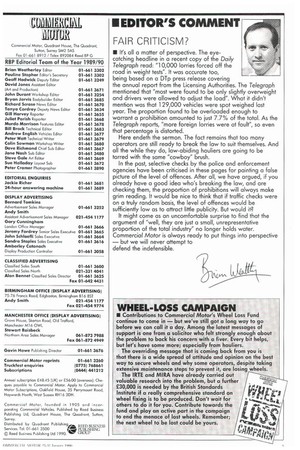II EDITOR'S COMMENT
Page 5

If you've noticed an error in this article please click here to report it so we can fix it.
FAIR CRITICISM?
• It's all a matter of perspective. The eyecatching headline in a recent copy of the Daily Telegraph read: "10,000 lorries forced off the road in weight tests". It was accurate too, being based on a Dip press release covering the annual report from the Licensing Authorities. The Telegraph mentioned that "most were found to be only slightly overweight and drivers were allowed to adjust the load". What it didn't mention was that 129,000 vehicles were spot weighed last year. The proportion found to be overloaded enough to warrant a prohibition amounted to just 7.7% of the total. As the Telegraph reports, "more foreign lorries were at fault", so even that percentage is distorted. Here endeth the sermon. The fact remains that too many operators are still ready to break the law to suit themselves. And all the while they do, law-abiding hauliers are going to be tarred with the same "cowboy" brush. In the past, selective checks by the police and enforcement agencies have been criticised in these pages for painting a false picture of the level of offences. After all, we have argued, if you already have a good idea who's breaking the law, and are checking them, the proportion of prohibitions will always make grim reading. It would be nice to think that if traffic checks were on a truly random basis, the level of offences would be sufficiently low as to attract little publicity. But would it? It might come as an uncomfortable surprise to find that the argument of "well, they are just a small, unrepresentative proportion of the total industry" no longer holds water. Commercial Motor is always ready to put things into perspective — but we will never attempt to defend the indefensible.
































































































































